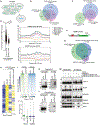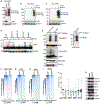SENP3 and USP7 regulate Polycomb-rixosome interactions and silencing functions
- PMID: 37014752
- PMCID: PMC10777863
- DOI: 10.1016/j.celrep.2023.112339
SENP3 and USP7 regulate Polycomb-rixosome interactions and silencing functions
Abstract
The rixosome and PRC1 silencing complexes are associated with deSUMOylating and deubiquitinating enzymes, SENP3 and USP7, respectively. How deSUMOylation and deubiquitylation contribute to rixosome- and Polycomb-mediated silencing is not fully understood. Here, we show that the enzymatic activities of SENP3 and USP7 are required for silencing of Polycomb target genes. SENP3 deSUMOylates several rixosome subunits, and this activity is required for association of the rixosome with PRC1. USP7 associates with canonical PRC1 (cPRC1) and deubiquitinates the chromodomain subunits CBX2 and CBX4, and inhibition of USP activity results in disassembly of cPRC1. Finally, both SENP3 and USP7 are required for Polycomb- and rixosome-dependent silencing at an ectopic reporter locus. These findings demonstrate that SUMOylation and ubiquitination regulate the assembly and activities of the rixosome and Polycomb complexes and raise the possibility that these modifications provide regulatory mechanisms that may be utilized during development or in response to environmental challenges.
Keywords: CP: Molecular biology; SENP3; SUMO; USP7; deSUMOylation; deubiquitination; epigenetics; gene silencing; heterochromatin; polycomb; rixosome; ubiquitin.
Copyright © 2023 The Author(s). Published by Elsevier Inc. All rights reserved.
Conflict of interest statement
Declaration of interests The authors declare no competing interests.
Figures




References
-
- Müller J, Hart CM, Francis NJ, Vargas ML, Sengupta A, Wild B, Miller EL, O’Connor MB, Kingston RE, and Simon JA (2002). Histone methyltransferase activity of a Drosophila Polycomb group repressor complex. Cell 111, 197–208. - PubMed
Publication types
MeSH terms
Substances
Grants and funding
LinkOut - more resources
Full Text Sources
Miscellaneous

